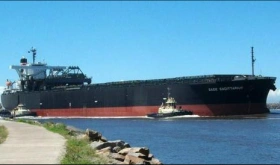A vessel was undergoing a periodical survey by a DNV class surveyor. A total of 19 air vent heads (mostly from ballast tanks) were found to be defective and the surveyor requested the master to repair this before leaving port. This example is taken from a DNV case but defective vent heads (sometimes also called air pipe closing devices) are frequently found in ship surveys, so this example is by no means unique.
The main findings for the 19 vent heads in the case discussed were:
- Guide pin broken in way of welding to float
- Guide pin broken at lower end due to corrosion
- Float shows signs of corrosion in way of weld seam, may crack in future
- Internal corrosion of housing
- Rubber seat dislodged making the float stuck & unable to operate
- Due to internal corrosion, rubber seat is dislodged
Defective air vent heads are a common finding during Port State Control inspections and will in most cases result in a detainable deficiency that must be rectified before leaving port.
The requirement of automatic closing devises on certain air pipes (from tanks) can be found in Load Line Regulation 20. This has been interpreted by IACS in Unified Requirements P3 (Air Pipe Closing Devices). The IACS UR P3 states some specific requirements for the design, materials and testing in order to have a common understanding between the Class societies for the approval of air vent heads.
A vent head shall be approved (product approval or type approval) by a recognised body (e.g. a Class Society) before being used on board a ship. This should also be kept in mind when replacing malfunctioning vent heads and for the general maintenance of parts.
The purpose of the air vent head (as defined in IACS UR P3.2.6) is:
- to prevent the free entry of water into the tanks
- to allow the passage of air or liquid to prevent excessive pressure or vacuum coming on the tank
The most probable cause of defective vent heads is the daily exposure to the outdoor environment on deck, occasional sprays from green seas and ballast water being pushed through the vent head during heavy rolling.
Lessons to be learned from the above include the following:
- Malfunctioning air vent heads are a common finding, for both the Class surveyor and the Port State Control inspector. Each vent head is an essential safety feature on board and should be kept in good condition. A broken air vent head will most probably result in a PSC deficiency which must be rectified before leaving port.
- The ship manager should ensure that there is a regular inspection and maintenance programme in place for the air vent heads on board its vessels. Since vent heads may be broken after only a few years in operation, DNV recommends inspecting each vent head annually. Such a programme should include the general condition (rust, dirt, functionality) and especially the condition of the float/ball/disc, guiding pin, seat and wire mesh (if installed). Needless to say that a vent head replacement shall be of an approved type and any replacement parts shall be of the original or an equivalent quality.
- Special attention shall be paid to air pipes and air vent heads located in the fore deck (1/4 L) due to green seas and the ship’s movement.
- A cheap air vent head can become an expensive experience. The trend seems to be to buy the least expensive vent heads for newbuildings. This often means stainless steel type 304 as an accepted material quality for the floats according to present requirements (Load Line and IACS UR P3). However, this does not mean that such stainless steel is maintenance free.
- Air vent heads made out of aluminium or other grades of stainless steel have become increasingly popular in the last few years. Such materials are options to be considered in order to achieve a more maintenance-free vent head.
Source: DNV














i found it a good blog.you guys doing a beautiful work on this…..i love it much…